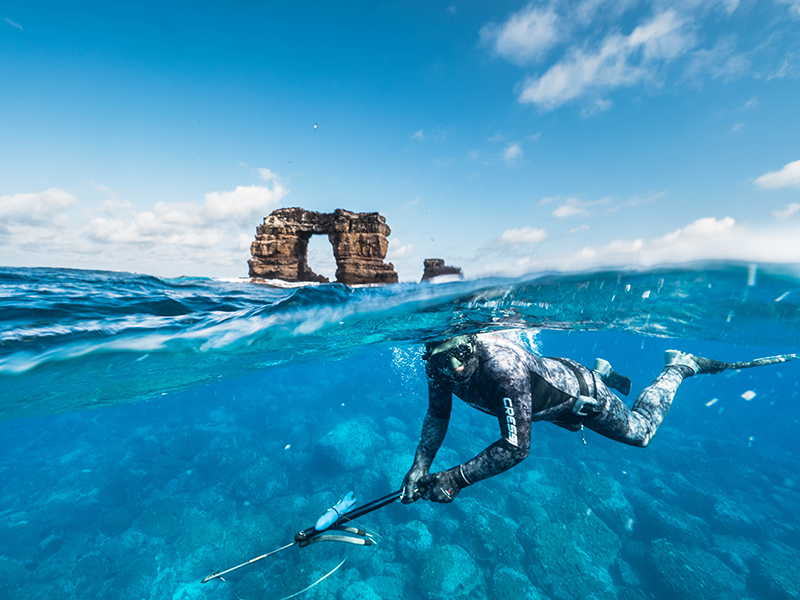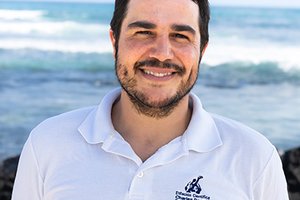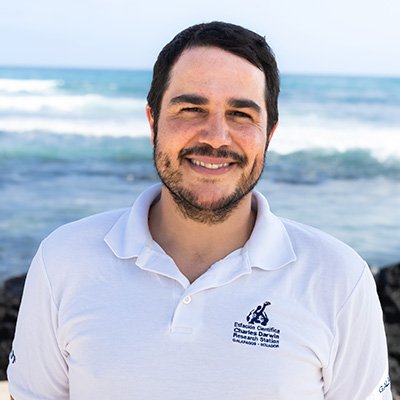Scientists from the Charles Darwin Foundation, working with the sharks ecology project, in collaboration with the Galapagos National Park Directorate (GNPD), the University of the Azores (Portugal) and the Nova Southeastern University (USA), have recently deployed, for the first time, towed satellite tags on 15 pregnant scalloped hammerhead sharks (Sphyrna lewini). This species of shark has recently been listed as critically endangered in the Red List of Threatened Species issued by the International Union for Conservation of Nature (IUCN). The objective of this study is to reveal the migratory pathways of these ‘mothers-to-be’ to nursery areas likely located on mainland mangrove bays distributed across the coasts of the Tropical Eastern Pacific. This is defined as an ecoregion that expands from southern Baja California in Mexico to northern Peru.

“We currently have no idea where, the thousands of pregnant female hammerheads that aggregate every year around Darwin and Wolf Islands in northern Galapagos, go to give birth to their babies”, says Dr. Salinas de León. He adds “This study is aimed at bringing some light to this serious knowledge gap about the life history of this critically endangered species. We anticipate that the vast majority of these pregnant sharks leave the safe heaven provided by the Galapagos Marine Reserve, to look for sheltered mangrove bays, their preferred shark kindergarten, along the continental coasts of South and Central Americas”. And concludes “By identifying the connectivity between the Galapagos Islands and these baby shark nursing habitats, located 1000 km away from Galapagos waters, is essential so we can protect them during their migration process in their way to give birth” says Dr. Pelayo Salinas de León, Senior Marine Scientist at the Charles Darwin Foundation and Conservation Scientist, with the National Geographic’s Pristine Seas project.

This is the first time researchers have used towed satellite tags on this species inside the Galapagos Marine Reserve (GMR). Now, each time the animal comes to the surface, the tag will transmit its position to the Argos satellite-based network so individual shark movements can be tracked in near real-time. These tags were deployed by researchers using specifically designed spears, while free diving at Darwin and Wolf Islands, which are home to the largest global shark biomass. Scientists use this method because hammerhead sharks are very wary of the noise generated by scuba diving equipment, and previous attempts by other research groups to capture this fragile species, have yielded poor results. These 15 satellite transmitters were deployed during a weeklong expedition, in early 2020, onboard the research vessel Taka III, which time was kindly donated by the Asociación Anticyclone (Portugal).

“Darwin and Wolf islands are one of the handful places in our planet where you can still be in the ocean among thousands of hammerhead sharks” says Dr. Jorge Fontes, shark researcher from the University of the Azores in Portugal and collaborating scientist of the CDF Shark Project. And he adds, “to successfully tag a hammerhead is all about anticipating and understanding their behaviour. You have to be at the right place at the right time, while choosing the right individual. This required up to 10 hours per day in the water, which was amazing as we got to really immerse ourselves in this wild and pristine oceanic ecosystem” says Dr. Fontes.
“The information obtained from these satellite tags, will be complemented by ongoing DNA-based parent-offspring analysis of pregnant sharks, sampled at the Galapagos, and of some juvenile sharks sampled in fishing markets from Ecuador, Colombia, Costa Rica and Panama”, says Prof. Mahmood Shivji, director of the Guy Harvey Research Institute and Save Our Seas Foundation of the Shark Research Center at Nova Southeastern University. Juvenile scalloped hammerhead sharks are frequently caught during artisanal fishing operations that use gillnets and long-lines, to harvest of prawns and other fish and seafood resources, near nursery areas in the South American coasts. The meat of sharks caught this way, is then sold for human consumption at local fish markets. “The removal of large numbers of offspring birthed by the migrating pregnant sharks can affect the health of the iconic Galapagos aggregation, so we need to confirm this connectivity”, adds Shivji.

“Hammerhead sharks do not care about marine reserve boundaries or individual country borders; they just follow their natural instincts when the time comes to conduct these epic regional migrations to birthing sites” comments Dr. Salinas de León. He concludes, “the recent listing of this species as critically endangered by the IUCN highlights the urgent need to expand protection regionally, including the protection of nursery grounds on the continental coasts of South and Central America, as well as seasonal fishing closures during the reproductive season”.
This research was possible thanks to the support of Mark Rohr/SY Acadia, the Gordon and Betty Moore Foundation, and National Geographic’s Pristine Seas.






